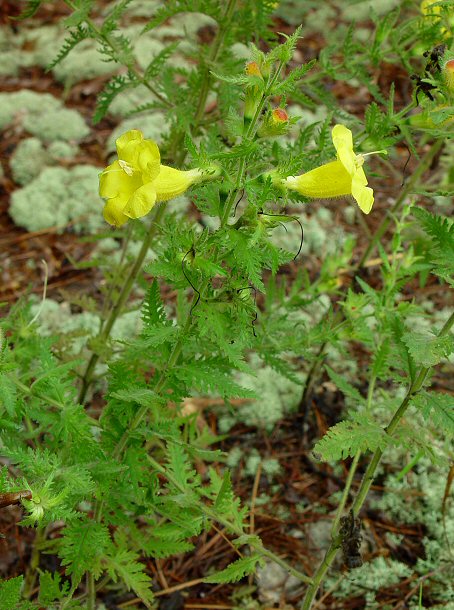Aureolaria pectinata (Nutt.) Pennell
False Foxglove

Native
CC = 7
CW = 5
MOC = 26
© DETenaglia
Aureolaria pectinata (Nutt.) PennellFalse Foxglove | |
 |
Native CC = 7 CW = 5 MOC = 26 |
© DETenaglia |
|
Family - Orobanchaceae Habit - Annual hemiparasitic forb. Stems - Ascending to erect, to 1 m, erect, branching, from stout whitish roots, mostly 4-angled, viscid, densely pubescent with multicellular, glandular hairs. Hairs of the stem both long and short.
Leaves - Opposite, short-petiolate to sessile, to 7 cm, pinnatifid, ovate, glandular-pubescent. Lobes divided again. Ultimate divisions acute. Leaves promptly deciduous as the plant dries.
Inflorescence - Open, terminal racemes with leafy bracts, or single axillary flowers in the upper stems and branches. Bracts 1-4 cm long, otherwise similar to leaves. Pedicels glandular-pubescent, to 1 cm, with expanded tips. Cleistogamous flowers absent. Flowers - Calyces 11-20 mm long, 4-5 lobed, densely glandular-hairy, the lobes longer than the tube, toothed or pinnately lobed. Corollas yellow, 30-40 mm long, glandular-hairy on the outer surface, the upper lobes glandular-hairy on the inner surface near the base, the margins usually also hairy. Corolla lobes rounded. Stamens 4, included to partially exserted, didynamous. Filaments to 1.5 cm long, one pair mostly glabrous, one pair pubescent to the apex. Anthers 6 mm long, bilobate, with pointed bases, dehiscing longitudinally, pubescent along the suture. Ovary superior, glabrous, 2-3 mm long and broad in flower, slightly compressed, whitish-green. Style glabrous, light green, to 1.5 m long in flower. Stigma darker green than the style, swollen.
Flowering - August - September. Fruits - Capsules 9-15 mm long, glandular-hairy. Seeds 0.6-1.2 mm long, with relatively short, fine ridges enclosing relatively large areoles. Habitat - Upland forests, borders of glades, bluffs, usually on acid substrates. Origin - Native to the U.S. Lookalikes - A. grandiflora, A. flava. The flowers of these three species are all very similar, but foliar characters provide easy differentiation. The species on this page is the only one with glandular pubescence on many plant parts, often making them sticky to the touch. The leaves are also more fernlike in appearance, with more regular lobing and finer ultimate divisions. Other info. - This species is found mainly in the Ozark region of Missouri, where it is reasonably common. Elsewhere it is found in the southeastern quadrant of the continental U.S. It is easily identified in the field from its large yellow flowers, finely divided leaves, and viscid stems covered with glandular hairs. The plant is worthy of cultivation and would do well with little care in a dry area of the garden. The species epithet derives from the fact that its leaves closely resemble those of another genus in the family, Pedicularis. Photographs taken off Hwy. Z, Carter County, MO., 8-31-03 (DETenaglia). |